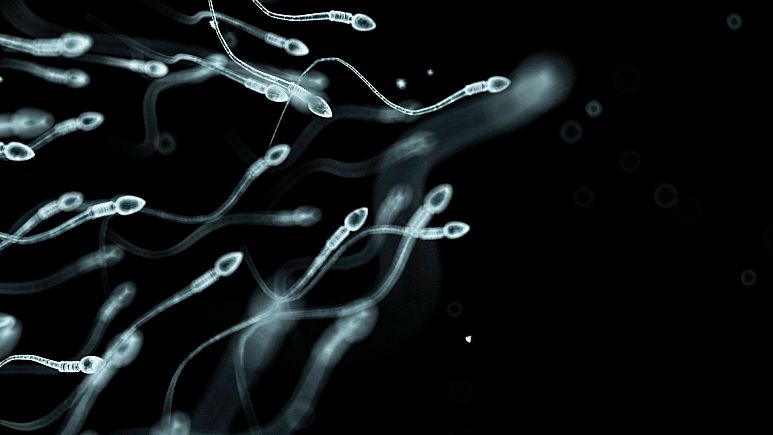Researchers have looked at nearly 27,000 studies to identify the biggest factors causing sperm damage. This is what they found.
Men’s reproductive capacity has fallen drastically in recent decades - and a new analysis of thousands of studies has revealed the factors that pose the biggest risk to sperm quality.
Sperm counts around the world have halved over the past 50 years, with the pace of decline more than doubling since 2000, according to recent research on male fertility.
Researchers at Semmelweis University in Hungary have dug deeper into the findings of nearly 27,000 studies to determine the biggest causes of deterioration of sperm cells, and found pollution, smoking, age, and certain health conditions to have the greatest effect.
Their findings were published in the journal Reproductive Biology and Endocrinology.
The functionality of sperm cells is tested by “DNA fragmentation analysis,” currently the only evidence-based test to make the determination, explained Dr Zsolt Kopa, head of the Andrology Centre at the Department of Urology at Semmelweis University.
"It examines their DNA content, namely the proportion of intact or fragmented genetic material in the sperm. The more fragmented the DNA, the less the sperm’s ability to fertilise; also, it can increase the risk of miscarriage," he said.
The research comes amid growing concern about the dramatic fall in male reproductive capacity. Research published late last year in the journal Human Reproduction Update showed that sperm counts worldwide have halved over the past five decades.
Professor Hagai Levine, one of the researchers behind that particular study, called it a "canary in a coal mine," adding that "we have a serious problem on our hands that, if not mitigated, could threaten mankind’s survival".
Age, pollution, lifestyle
The Semmelweis scientists searched three international databases for previously published studies, finding 26,901 articles, and using 190 for their meta-analysis. All were published between 2003 and 2021, mostly in Europe, the US, and Asia, with some in Africa and Australia.
Data of thousands of men treated in infertility clinics were compared - and some results surprised even the researchers.
"Based on previous research, we expected that the quality of sperm cells starts to deteriorate significantly after age 40, but our meta-analysis suggests that this age could be much higher," said Dr Anett Szabó, a PhD student and first author of the Semmelweis publication.
"But, of course, this is not to say that it’s worth waiting to start a family as other important parameters can also deteriorate with advancing age".
The researchers did find that the studies demonstrated smoking could increase DNA fragmentation by an average of 9.19 per cent compared to non-smokers.
Alcohol, and body weight, didn’t have a clinically significant role in the fragmentation of the genetic material. A tendency that more alcohol and higher body weight lead to more considerable fragmentation was detectable, however.
Pollution had a clear detrimental effect on sperm quality. Two of the studies reviewed showed the effect on sperm in a region in Italy with particularly high environmental pollution, while another showed similar effects on police officers directing traffic at a busy junction.
The meta-analysis found that various factors, such as air pollution, the exposure to pesticides or insecticides, increased sperm DNA fragmentation by an average of 9.68 per cent.
Underlying health problems
Certain health problems were also shown to be a factor. Varicocele, which is the dilation of the veins in the spermatic cord, was found to increase fragmentation by an average of 13.62 per cent while reduced glucose tolerance also affects it to a similar extent.
Tumours, meanwhile, can cause an 11.3 per cent increase in fragmentation.
Infections such as Chlamydia and HPV did not appear to impair sperm quality, but bacterial or other STIs did show a slight increase in fragmentation.
"In recent years, there has been an increasing demand to measure men’s fertility with functional, objective parameters, in addition to the classical quantitative and qualitative characteristics," said Kopa.
"DNA fragmentation can be of outstanding importance, and the test was officially included in the international guidelines in 2021. However, there are still no official standards on the values of infertility and fertility," he added.
"In clinical practice, we use only consensus values. Generally, a fragmentation below 25 per cent can be considered optimal; above this, the chance of spontaneous conception decreases. Beyond 50 per cent, the success rate of IVF is also lower".
The experts added that quitting smoking, getting enough exercise, or eating more healthily could be a good start for people who are planning to try for a child.



Recommended Comments
There are no comments to display.
Join the conversation
You can post now and register later. If you have an account, sign in now to post with your account.
Note: Your post will require moderator approval before it will be visible.